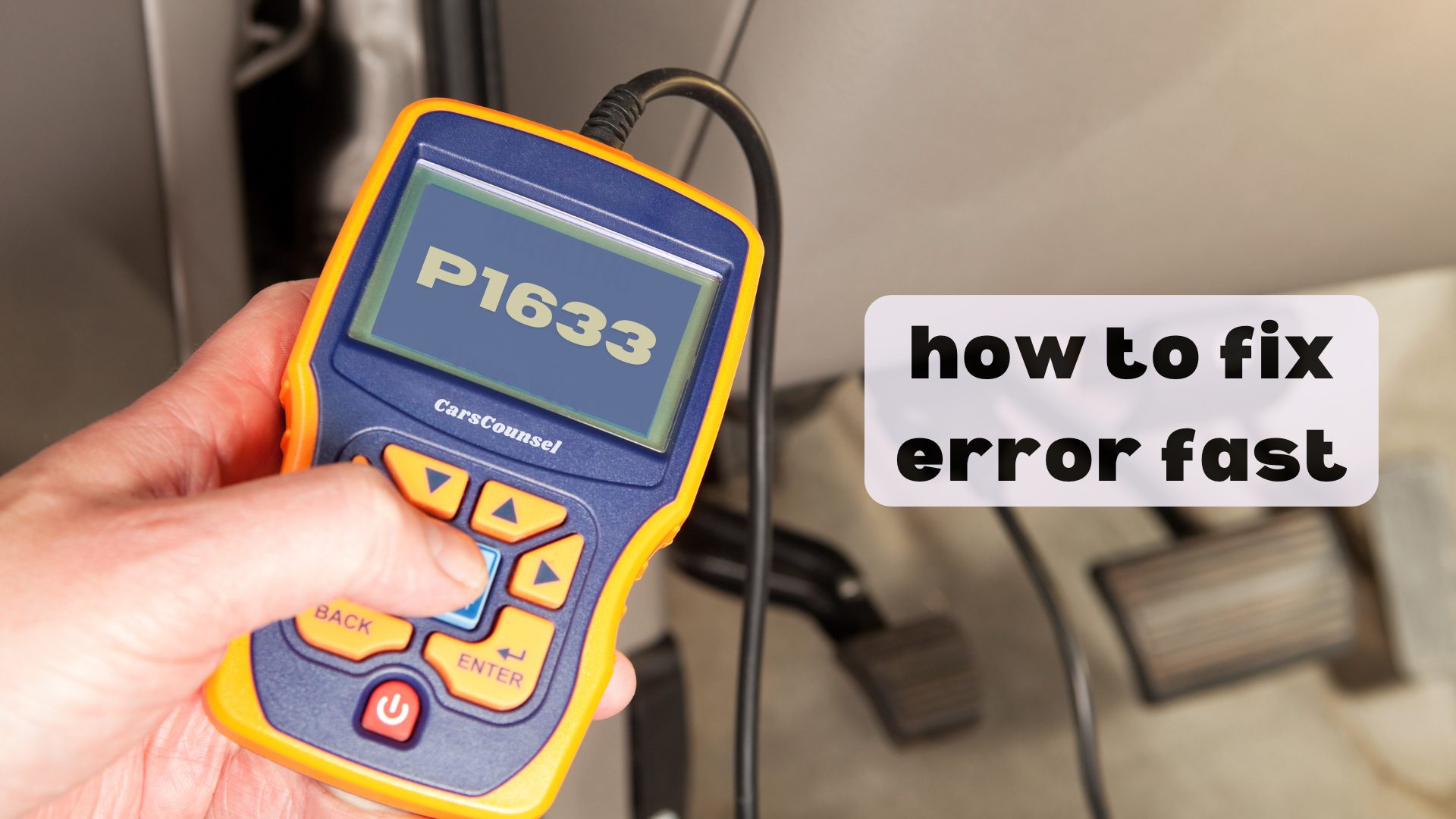When you see the P1633 code on your vehicle, it’s important to fix it quickly to prevent more problems. This error usually points to issues with the throttle position sensor or the fuel level sensor, both of which are crucial for your car’s performance.
Start by using an OBD-II scanner to confirm the error code, then check the electrical connections for any signs of rust or damage.
But what if the usual fixes don’t solve the problem? Keep reading to find out the advanced steps you can take to make sure your car runs smoothly again.

Quick Navigation
Key Takeaways
- Use an OBD-II scanner to find and clear the P1633 error code.
- Check the throttle position sensor and replace it if it’s not working.
- Look at all electrical connections for any signs of corrosion or damage and clean them.
- Make sure the fuel level sensor is working and replace it if needed.
Understanding P1633 Code
The P1633 code means there’s a problem with your car’s throttle control system. This system helps manage how your engine gets fuel and air, which is crucial for smooth driving.
The throttle position sensor is a key part of this system, as it tracks the position of your gas pedal and sends this information to the engine’s computer. If this sensor isn’t working right, your engine won’t perform well, and you’ll likely use more gas.
If you ignore this issue, it could eventually lead to engine failure. It’s important to diagnose and fix this problem quickly to keep your engine running smoothly and avoid expensive repairs.
Regularly checking and maintaining your throttle control system can help prevent issues.
Causes of P1633 Code
A P1633 code can pop up due to a few different problems, like a bad fuel level sensor, wiring issues, or a faulty throttle position sensor. If the fuel sensor isn’t working right, it can mess up the fuel-air mix, leading to problems with the throttle. Bad wiring or loose connections can also mess with the signals, causing the P1633 code. Plus, if the throttle position sensor isn’t working properly, it can give wrong readings and affect how the engine runs.
Here’s a simple breakdown:
| Cause | Impact | Solution |
|---|---|---|
| Bad Fuel Level Sensor | Wrong fuel readings affecting combustion | Replace the sensor |
| Wiring Issues | Messed-up signals causing throttle problems | Fix or replace the wiring |
| Faulty Throttle Position Sensor | Wrong throttle readings affecting engine | Replace the throttle position sensor |
Fixing these issues quickly can help avoid more problems down the road.
Common Issues Linked to P1633
You often see the P1633 code because of problems with parts like the fuel level sensor or throttle position sensor, or issues with wiring and electrical connections. A bad fuel sensor can mess up throttle control, leading to the wrong fuel-air mix and causing the P1633 code.
Wiring issues, like broken wires or rusty terminals, can also stop sensors from working properly. Bad throttle position sensors are another common cause because they don’t send accurate info to the engine control module.
Additionally, corroded electrical connections and damaged wiring can make this code pop up. Keeping these parts in good shape and making sure all electrical connections are solid can help stop the P1633 code from coming back.
Symptoms of P1633 Code
Several clear symptoms can indicate a P1633 code, such as dashboard warning lights, incorrect fuel gauge readings, performance problems, and potential stalling. This code often leads to noticeable electrical system issues, so it’s important to address it quickly.
You might see your vehicle’s fuel gauge acting strangely or giving wrong readings, which can affect how you manage your fuel.
Additionally, you may experience performance issues like reduced engine power, throttle hesitation, and even stalling due to the throttle sensor being affected. These symptoms aren’t just annoying but can also be dangerous if ignored.
Regular diagnostic checks and immediate attention to these signs can help reduce the impact and prevent further damage to your vehicle’s throttle control system.
Affected Car Models
If you’re seeing the P1633 error code, it’s good to know which car models are often affected.
For example, the Ford F-150 is known to have issues with the fuel level sensor circuit, which can cause incorrect fuel readings and make the truck perform poorly.
Similarly, the Dodge RAM can have similar fuel sensor problems that trigger the same error code.
In Honda Civics, the P1633 code often comes up because of issues with the throttle position sensor.
Although these specific models are mentioned, older cars from various brands are generally more likely to have this problem due to worn-out parts.
Keep an eye out if your car has a throttle control system because P1633 can show up in many different makes and models.
Diagnosing P1633 Code
When diagnosing the P1633 code, start by using an OBD-II scanner to read the error codes from the car’s computer. Then, check if the throttle and the throttle position sensor (TPS) are working properly. Look at the electrical connections to see if there’s any corrosion or damage.
| Diagnostic Step | Action | Keywords |
|---|---|---|
| Retrieve Codes | Use OBD-II scanner | onboard computer |
| Inspect TPS | Check for malfunction | throttle calibration |
| Examine Connections | Look for corrosion | sensor replacement |
| Verify Fuel Level | Test sensor functionality | fuel level sensor |
Make sure the battery has enough voltage to avoid any errors in the car’s computer. Use a voltmeter to check if the TPS output matches the factory settings.
Diagnostic Steps
Start diagnosing the P1633 code by connecting an OBD-II scanner to your car’s diagnostic port to get any error codes from the car’s computer.
Use the scanner to check the electrical connections for any rust or damage.
Test the fuel level sensor to make sure it’s working right.
Check the wiring to see if it’s in good condition.
Look at the Powertrain Control Module (PCM) for any problems or software issues.
Use a voltmeter to check if the throttle position sensor is giving the correct readings based on factory settings.
Make sure the battery has enough voltage to avoid causing errors in the PCM.
Other OBD codes can give you more clues for diagnosing the P1633 code.
Fixing P1633 Code
After finding out the P1633 code, you can start fixing it by replacing the Throttle Position Sensor if it’s broken. This sensor is important because it helps manage how the engine gets the right mix of fuel and air.
First, disconnect the battery to avoid any electrical problems. Find the Throttle Position Sensor, which is usually near the throttle body. Unscrew the old sensor and unplug the wiring.
Put in the new sensor, making sure it’s tightly secured and connected. Reconnect the battery and use an OBD-II scanner to clear the error code.
Test the car to make sure the throttle response is better and that the P1633 code is gone. Replacing the sensor is a simple fix that helps the engine run well.
Preventing P1633 Code
To prevent the P1633 code from popping up, it’s important to keep up with regular maintenance and inspections of your car’s electrical parts, sensors, and battery.
Start by regularly checking the electrical system to spot any potential problems like rusty terminals or damaged wires.
Make sure the battery is in good shape and has the right voltage.
Also, often check the throttle position sensor and fuel level sensor for any signs of wear or issues.
Clean and secure all connections to ensure everything communicates properly.
Cost of Repairs
The cost to fix the P1633 code can vary a lot, depending on what’s wrong and which parts need to be fixed. Simple repairs like cleaning corroded connections or minor wiring issues might only cost a few hundred dollars. However, more complicated fixes, like replacing the fuel level sensor or the Powertrain Control Module (PCM), can go over a few thousand dollars. To get a good idea of the repair costs, it’s important to compare prices from different mechanics. Here’s a rough guide to help:
| Repair Type | Estimated Cost | Complexity Level |
|---|---|---|
| Cleaning Connections | $100 – $200 | Low |
| Wiring Repairs | $200 – $500 | Medium |
| Throttle Position Sensor | $300 – $800 | Medium |
| Fuel Level Sensor | $400 – $1,200 | High |
| PCM Replacement | $1,000 – $3,000+ | Very High |
Getting accurate cost estimates and comparing mechanics is key to planning your repair budget.
More OBD-II Codes
Frequently Asked Questions
What Tools Do I Need to Diagnose the P1633 Code Myself?
You’ll need some basic tools to diagnose the P1633 code yourself. These include an OBD-II code reader to read error codes, a multimeter to test electrical connections, and wiring diagrams to understand the wiring. These tools will help you figure out what’s causing the P1633 code.
How Long Does It Typically Take to Fix the P1633 Code?
Usually, it takes about 2-4 hours to fix the P1633 code. The time can vary depending on the diagnosis. If it’s a complicated issue like fixing the wiring, it might take longer. Simple fixes, like cleaning connections, are quicker.
Can a P1633 Code Affect the Vehicle’s Emissions Test Results?
Yes, the P1633 code can affect your vehicle’s emissions test results. Problems with sensors or wiring can lead to poor engine performance, which increases emissions and may cause your vehicle to fail the test.
Is It Safe to Drive My Car With the P1633 Code Active?
Driving with the P1633 code active isn’t safe. You might notice your engine doesn’t perform as well, it could stall, and you’ll probably use more fuel. Fix the problem as soon as you can to stay safe and avoid more issues.
Are There Any Temporary Fixes for the P1633 Code Until Professional Repair?
Quick fixes usually don’t solve the problem for long. But if you’re in a pinch, you can try cleaning any corroded connections or checking the battery voltage. These might help you get by until you can get proper repairs done.
Conclusion
To sum it up, fixing the P1633 code quickly means doing careful and consistent checks.
Start by verifying the code with an OBD-II scanner. Then, check all connectors and sensors, and replace any damaged parts.
Clear the code, take the car for a thorough test drive, and make sure everything is working properly.
Regular maintenance and monitoring can help prevent these issues, ensuring your car runs smoothly.
Keep your car’s systems in sync, and you’ll save time, hassle, and trips to the mechanic.

